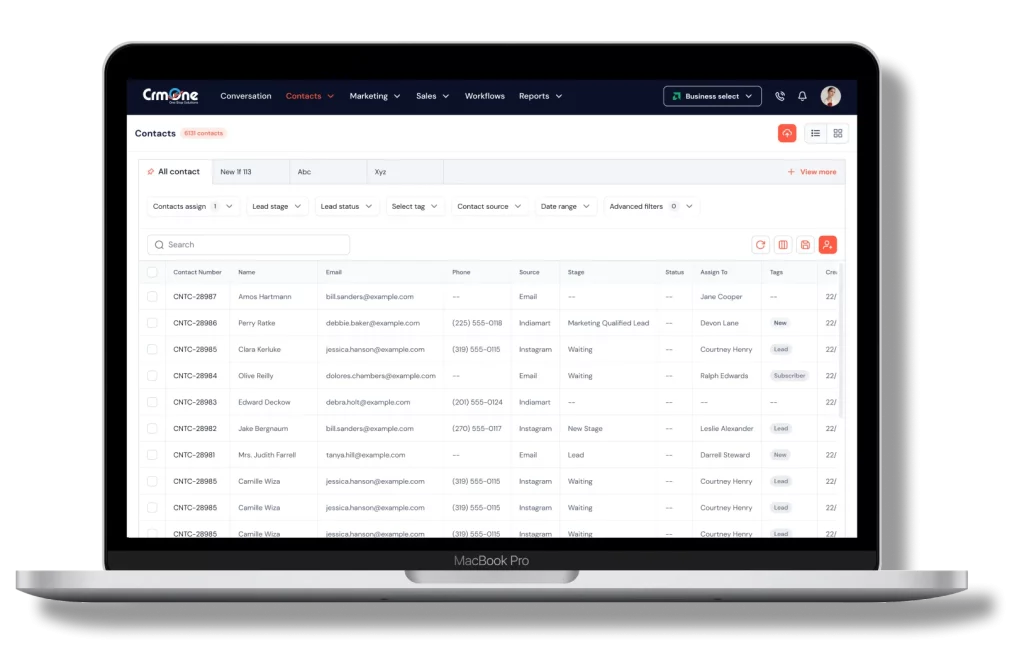What is Lead management process in today’s fast-paced business world? It involves capturing and organizing potential customers’ information, ensuring that every lead is nurtured and directed through the sales funnel with precision and care. This process is about more than just handling data and building relationships. Through effective lead management, businesses can transform curious browsers into loyal customers, fostering growth and ensuring long-term success.
Why is this process so crucial in the modern business landscape? In an era of fierce competition and short attention spans, quickly identifying and responding to potential leads can set a company apart. It’s not enough to have software or a lead management system; what matters is how well these tools are applied to interact with prospects, assess their needs, and influence their buying decision. This is where lead nurturing comes into play, a key component of customer relationship management that helps businesses develop strong, lasting connections with their audience.
Incorporating lead management software into a company’s strategy is more than a technological upgrade—it’s a commitment to enhancing customer experience and maximizing the efficiency of sales efforts. Such systems not only streamline the tracking and managing of leads but also provide invaluable insights into customer behavior, preferences, and feedback. This, in turn, enables businesses to tailor their offerings and communication strategies to meet the unique needs of their market.
In summary, lead management process is the cornerstone of a successful business strategy. It ensures that every interaction with a potential customer is an opportunity to build a relationship and drive sales. By leveraging lead management systems and embracing effective lead management practices, companies can achieve a competitive edge, turning leads into loyal customers and driving sustainable growth.
What is Lead Management Process?

Lead management is a strategic process vital for businesses looking to optimize their sales funnel and convert more prospects to customers. It involves several key steps designed to attract, track, and manage potential clients, guiding them smoothly from initial interest to the final purchase. Let’s break down this concept to understand its definition, scope, and crucial role in today’s business environment.
Definition and Scope
Lead Management Defined:
At its heart, lead management is about capturing data on individuals interested in your product or service, assessing their interest and potential to buy, and nurturing those leads until they’re ready for direct engagement with the sales team. It’s a comprehensive approach covering every touchpoint in a prospect’s journey, from the first interaction with your brand to the moment they decide to purchase.
Scope of Lead Management:
The scope of lead management extends beyond mere data collection. It encompasses analyzing consumer behavior, managing communications, and providing personalized experiences. Most lead management systems include tools for lead capture, scoring, distribution, and nurturing, enabling businesses to understand and cater to the needs of their potential clients at every stage of the sales process.
Role in Converting Prospects to Customers
Streamlining the Sales Funnel:
Lead management plays a pivotal role in organizing the sales process. Businesses can keep potential customers from falling through the cracks by effectively tracking and managing leads. This process helps prioritize leads based on their likelihood of converting, allowing the sales team to focus their efforts where they’re most needed.
Bridging Sales and Marketing Teams:
Effective lead management fosters closer collaboration between sales and marketing teams. Marketing efforts generate leads by capturing interest through various channels while the sales team converts those leads into customers.
Lead management bridges these two functions, ensuring that both teams are aligned in their goals and strategies. This alignment is crucial for nurturing leads effectively, as it ensures that marketing messages and sales tactics are consistent and complementary.
Personalizing Customer Interactions:
Effective lead management starts with an understanding of consumer behavior. Most lead management systems can customize communications and offers to each lead based on their unique requirements and interests by examining how potential customers engage with your business.
Because prospects are more inclined to interact with material and offer that align with their tastes, this tailored strategy greatly boosts the likelihood of turning leads into devoted clients.
Lead Management Process
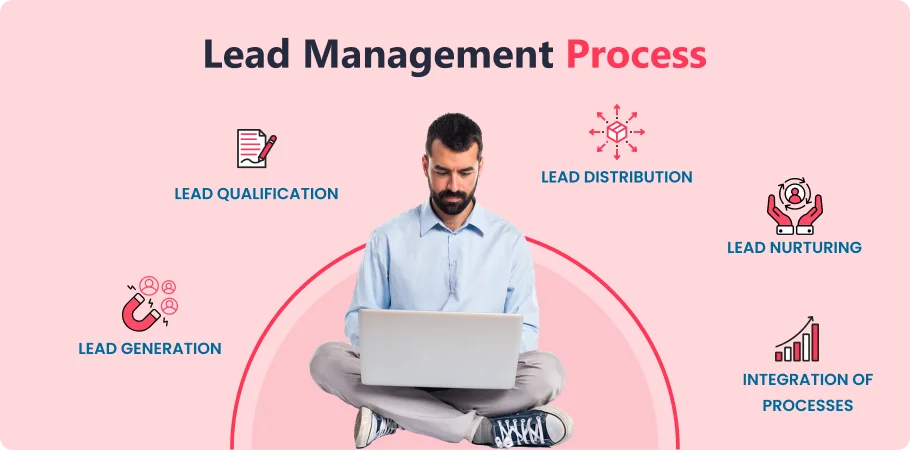
The lead management process is a comprehensive strategy designed to optimize the journey of a potential customer from initial interest to making a purchase. This process encompasses several critical stages: lead generation, lead qualification, lead distribution, and lead nurturing. Each stage ensures that leads are effectively managed and nurtured through the sales cycle. Here’s a closer look at each step.
Lead Generation: Capturing Lead Information
What It Involves:
The lead generation process begins with attracting potential customers to your business. This stage utilizes various marketing channels, such as social media, email campaigns, webinars, and content marketing, to capture the interest of potential leads.
Why It’s Important:
This first step is crucial for building a broad base of leads to enter the sales funnel. Effective lead-generation strategies ensure that your marketing and sales teams have a steady flow of sales leads, laying the groundwork for the subsequent stages of lead management.
Lead Qualification: Determining Lead Readiness
What It Involves:
Once leads are generated, the next step is to assess their readiness and potential to become customers. This stage categorizes leads into various segments, such as marketing qualified leads (MQLs) or sales qualified leads (SQLs), based on their engagement level, interest, and fit for your product or service.
Why It’s Important:
Lead qualification helps filter out leads that need to be ready or suitable for the sales cycle, allowing sales teams to focus on leads with the highest conversion potential. This step ensures that resources are allocated efficiently, improving the overall effectiveness of the lead management process.
Lead Distribution: Assigning Leads to Appropriate Sales Reps
What It Involves:
Lead distribution involves assigning qualified leads to the right sales reps based on various criteria, such as geographic location, industry, or product of interest.
Why It’s Important:
Effective lead distribution ensures that leads are handled by the most suitable sales team member, which can significantly increase the chances of conversion. This step ensures that each sales lead receives personalized attention, increasing the efficiency of the sales process.
Lead Nurturing: Building Relationships with Not Yet Ready-to-Buy Leads
What It Involves:
Lead nurturing focuses on developing relationships with leads that need to be ready to purchase. Businesses aim to nurture leads through targeted content, personalized email communications, and engagement strategies by providing value and maintaining interest throughout the buyer’s journey.
Why It’s Important:
Not all leads are ready to buy immediately. Lead nurturing allows businesses to stay top of mind with these potential customers, gradually guiding them closer to a purchasing decision. This stage is critical for building trust and loyalty, even before the lead becomes a customer, enhancing the quality and quantity of qualified sales leads.
The Integration of Processes
Lead Tracking and Continuous Optimization:
Throughout all these stages, lead tracking plays a crucial role in monitoring each lead’s progress. By analyzing how leads move through the sales cycle, businesses can identify bottlenecks and opportunities for improvement, ensuring that the lead management process is continually optimized for better results.
In summary, the lead management process is a meticulously structured approach that guides potential customers through the sales cycle. From the initial lead generation process to nurturing leads still needing to be ready to buy, each step contributes significantly to filtering and preparing leads for the sales teams. This strategic alignment of marketing and sales teams ensures that every lead is given the best chance to convert into a loyal customer.
Book a CrmOne Demo
Experience the CrmOne simplicity and power. Our experts will show you the best ways to use it and answer your questions in real time. See how CRMOne fits your needs.
Implementing a Lead Management System
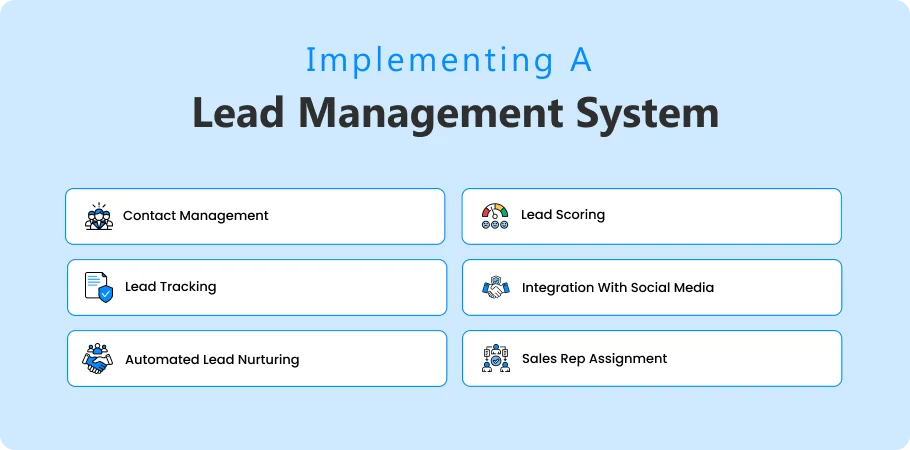
Let’s delve into the critical features of an effective system, its integration with other tools, and tips for choosing the right solution.
Features of an Effective Lead Management System
Contact Management:
Centralizes all lead and customer information, enabling easy access and management. This feature is crucial for maintaining detailed profiles of each lead’s behavior, preferences, and interactions.
Lead Scoring:
It assigns lead scores based on specific actions, engagement levels, or demographic information, helping prioritize the right sales-ready leads.
Lead Tracking:
Offers insights into the buying process by tracking lead behavior across various channels, including social media marketing efforts, website visits, and email interactions.
Integration with Social Media:
Facilitates the ability to collect leads from social media marketing campaigns directly into the lead management system, ensuring every potential lead is noticed.
Automated Lead Nurturing:
Automatically sends targeted messages and content to incoming leads at different stages of the buying process, helping to accelerate sales.
Sales Rep Assignment:
Efficiently distributes incoming leads to the appropriate sales rep, ensuring the most suitable person handles leads to convert them into sales-ready leads.
Integration with CRM and Marketing Automation Tools
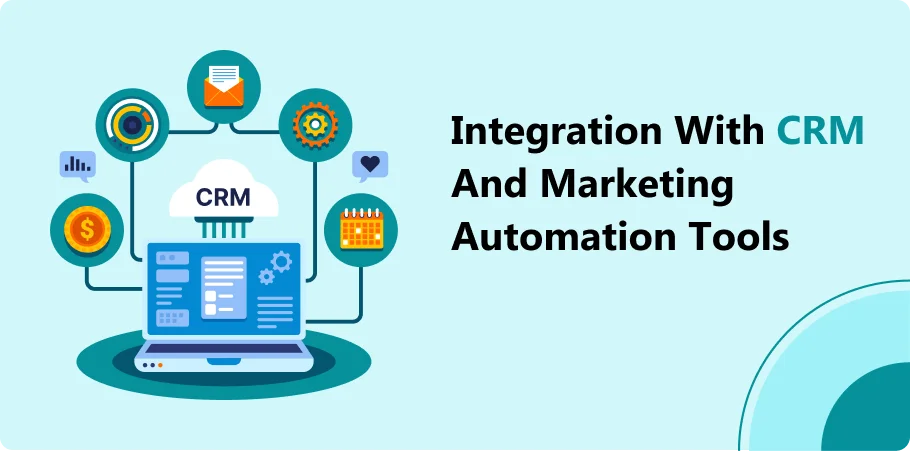
A robust lead management system should seamlessly integrate with existing CRM (Customer Relationship Management) and marketing automation tools. This integration enables:
Unified Data Management:
Ensures that all contact management data is synchronized across platforms, providing a single source of truth for all interactions with leads and actual customers.
Enhanced Lead Nurturing:
Allows for more personalized and effective nurturing campaigns by leveraging detailed insights from the lead management system and CRM tools.
Efficient Lead Conversion:
Ensures that sales-ready leads are quickly identified and passed to the sales team, streamlining the sales pipeline and helping to accelerate sales.
Choosing the Right Lead Management System for Your Business

Selecting the ideal lead management system involves understanding your business’s unique needs and challenges. Consider the following:
Assess Your Needs:
Determine the specific features you need, such as advanced lead scoring, social media integration, or detailed lead tracking.
Evaluate Integration Capabilities:
Choose a system that can integrate smoothly with your existing CRM and marketing automation tools to ensure seamless data flow and contact management.
Consider Scalability:
The system should be able to grow with your business, handling an increasing volume of leads and expanding sales pipeline needs without compromising performance.
User-Friendliness:
Ensure the system is intuitive and easy for your sales and marketing teams to use, from collecting leads to converting them into sales-ready leads.
Support and Training:
Look for vendors that offer comprehensive support and training resources to help your team make the most of the system.
In summary, a lead management system is an indispensable tool for businesses looking to efficiently acquire leads, nurture them through the sales pipeline, and ultimately convert them into actual customers. By focusing on key features, ensuring seamless integration with existing tools, and choosing a system that meets your specific needs, your business can significantly accelerate sales and improve the efficiency of its sales process.
The Sales Process and Lead Management
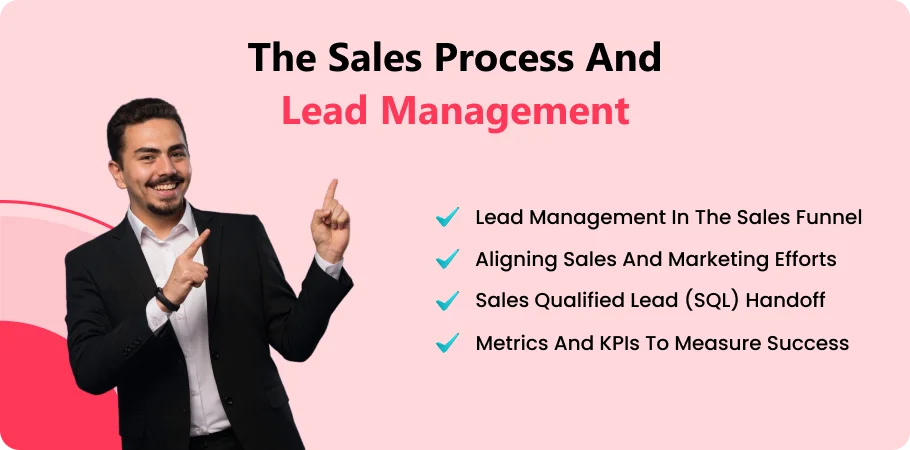
Understanding the intricate relationship between lead management and the sales process is crucial for businesses aiming to enhance their conversion rates and streamline their sales funnel. An effective lead management strategy ensures that high-quality leads are identified and nurtured and guarantees that the marketing team and sales professionals work in unison for maximum efficiency. Let’s explore how lead management fits into the sales funnel, the significance of aligning sales and marketing efforts, and the metrics and KPIs that measure success.
Lead Management in the Sales Funnel
Foundation of the Funnel:
Lead management acts as the foundation of the sales funnel, ensuring that all leads entering the funnel are accurately captured, assessed, and nurtured. Without a solid lead management system, even the most well-designed sales funnel can fail to convert leads into customers.
From Awareness to Decision:
An effective lead management strategy guides potential customers from the initial awareness stage through consideration and decision-making. By effectively managing leads, businesses can shorten the longer sales cycle and increase the efficiency of each sales call.
Aligning Sales and Marketing Efforts
Unified Goal:
Aligning marketing team efforts with sales professionals’ primary goal is to ensure that both teams are targeting the same objectives, primarily focusing on generating and converting high-quality leads.
Shared Insights:
Through effective lead management, both teams can share valuable insights about lead behavior, preferences, and feedback, which in turn helps craft tailored direct-to-consumer strategies and personalized sales approaches.
Sales Qualified Lead (SQL) Handoff:
A crucial aspect of lead management is the process of qualifying leads and handing off sales-qualified leads to the sales team at the right moment. This ensures that sales efforts are focused on leads that are ready to buy.
Metrics and KPIs to Measure Success
Conversion Rates:
One primary indicator of an effective lead management system is an improvement in conversion rates, from lead to sales-qualified lead and from SQL to a paying customer.
Lead to Sale Conversion Time:
This metric measures the time it takes for a lead to move through the sales funnel to become a customer, highlighting the efficiency of the lead management and sales processes.
ROI of Lead Generation Campaigns:
By analyzing the return on investment for different lead generation strategies, businesses can allocate resources more effectively to channels that produce the highest-quality leads.
Customer Lifetime Value (CLTV):
An essential KPI for measuring long-term success, CLTV helps assess the value a customer brings over their entire relationship with the company, emphasizing the importance of nurturing leads and customers alike.
Best Practices in Lead Management

Adopting the best practices for lead management ensures that businesses can effectively manage leads, guiding them from initial interest to the final sale. The success of this process hinges on using the right lead management tools, responding promptly to inquiries, personalizing the customer journey, and constantly refining strategies based on insights. Let’s delve into these practices for optimal lead management.
Timely Response to Lead Inquiries
Quick Engagement:
Responding swiftly to lead inquiries is crucial. The faster you engage with capturing leads, the higher the chances of conversion. Immediate responses signal to potential customers that their business is valued and that you’re ready to meet their needs.
Personalization and Segmentation in Lead Nurturing
Tailored Communication:
Utilizing data from market research and previous interactions to personalize messages can significantly increase engagement. Personalization shows that you understand the customer’s specific needs and challenges.
Effective Segmentation:
Segmenting leads based on behavior, preferences, or demographics allows for more targeted and relevant communication. By identifying the nuances in your lead collection, you can tailor nurturing efforts to resonate with each segment, fostering a deeper connection.
Continuous Analysis and Refinement:
Leverage Analytics: Continuous analysis of how leads move through your sales funnel provides valuable insights. Use analytics to identify patterns or bottlenecks that could be optimized.
Refine Based on Feedback: Incorporating feedback from successful conversions and unqualified leads helps refine your lead management process. Understanding why leads didn’t qualify or chose not to buy can offer critical insights for improvement.
Update Strategies Regularly: The market and consumer behaviors constantly evolve, necessitating regular lead management strategy updates. Keeping your tactics fresh ensures you stay ahead of changes in the market and consumer expectations.
Conclusion
In this blog, we’ve delved into the essence of lead management and its critical role in bridging the gap between sales and marketing efforts, ultimately driving new business growth and fostering solid relationships with prospective customers. Lead management software, practical strategies, and analytics tools form the backbone of this process, enabling businesses to capture, qualify, nurture, and convert leads more efficiently.
Lead management is not just about managing leads; it’s about understanding and engaging with prospective customers at every stage of their journey. Businesses can significantly enhance their sales and marketing outcomes by implementing the best practices discussed, including timely responses, personalization, segmentation, and continuous refinement of the lead management process.
The strategic integration of lead management software and analytics tools provides valuable insights that help refine strategies, improve customer engagement, and accelerate the sales cycle. This strategic approach underscores the importance of lead management in achieving business objectives, highlighting its role as a critical driver of growth and customer satisfaction.
Effective lead management is essential for any business looking to thrive in today’s competitive landscape. By prioritizing the capture and care of leads through sophisticated strategies and technologies, companies can unlock their full potential, turning prospective leads into loyal customers and ambassadors for their brand.
Get started for Free
Start for free today. Boost your sales by clicking the Get Started button. With CRMOne, you can manage leads, sales, and customer service all in one place.


